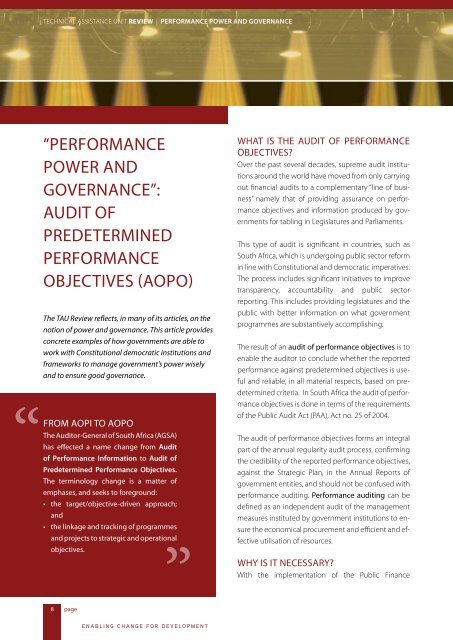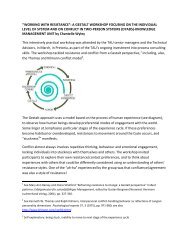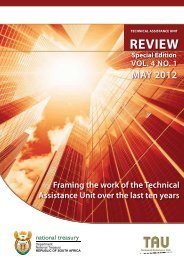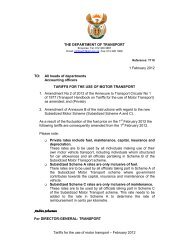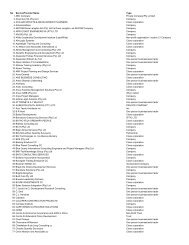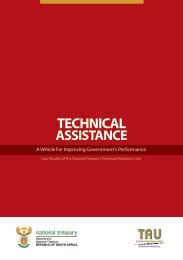Review 3 final 2 - TAU - National Treasury
Review 3 final 2 - TAU - National Treasury
Review 3 final 2 - TAU - National Treasury
Create successful ePaper yourself
Turn your PDF publications into a flip-book with our unique Google optimized e-Paper software.
TECHNICAL ASSISTANCE UNIT REVIEW | Performance Power and Governance<br />
“Performance<br />
Power and<br />
Governance”:<br />
Audit of<br />
Predetermined<br />
Performance<br />
Objectives (AOPO)<br />
The <strong>TAU</strong> <strong>Review</strong> reflects, in many of its articles, on the<br />
notion of power and governance. This article provides<br />
concrete examples of how governments are able to<br />
work with Constitutional democratic institutions and<br />
frameworks to manage government’s power wisely<br />
and to ensure good governance.<br />
“<br />
has effected a name change from Audit<br />
From AoPI to AOPO<br />
The Auditor-General of South Africa (AGSA)<br />
of Performance Information to Audit of<br />
Predetermined Performance Objectives.<br />
The terminology change is a matter of<br />
emphases, and seeks to foreground:<br />
• the target/objective-driven approach;<br />
and<br />
• the linkage and tracking of programmes<br />
”<br />
and projects to strategic and operational<br />
objectives.<br />
What is the audit of performance<br />
objectives<br />
Over the past several decades, supreme audit institutions<br />
around the world have moved from only carrying<br />
out financial audits to a complementary “line of business”<br />
namely that of providing assurance on performance<br />
objectives and information produced by governments<br />
for tabling in Legislatures and Parliaments.<br />
This type of audit is significant in countries, such as<br />
South Africa, which is undergoing public sector reform<br />
in line with Constitutional and democratic imperatives.<br />
The process includes significant initiatives to improve<br />
transparency, accountability and public sector<br />
reporting. This includes providing legislatures and the<br />
public with better information on what government<br />
programmes are substantively accomplishing.<br />
The result of an audit of performance objectives is to<br />
enable the auditor to conclude whether the reported<br />
performance against predetermined objectives is useful<br />
and reliable, in all material respects, based on predetermined<br />
criteria. In South Africa the audit of performance<br />
objectives is done in terms of the requirements<br />
of the Public Audit Act (PAA), Act no. 25 of 2004.<br />
The audit of performance objectives forms an integral<br />
part of the annual regularity audit process, confirming<br />
the credibility of the reported performance objectives,<br />
against the Strategic Plan, in the Annual Reports of<br />
government entities, and should not be confused with<br />
performance auditing. Performance auditing can be<br />
defined as an independent audit of the management<br />
measures instituted by government institutions to ensure<br />
the economical procurement and efficient and effective<br />
utilisation of resources.<br />
Why is it necessary<br />
With the implementation of the Public Finance<br />
8<br />
page<br />
Enabling change for development


